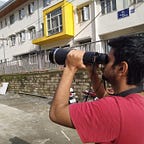Science Writing: Working of a Sewing Machine
Introduction
You might have seen your mother using a hand-operated or an electric sewing machine. Whatever is the source of power, the working principle is quite similar It is fairly simple: one needle, two threads, one needle moving up and down, stitch formed. That’s it. They are made of many pieces which synchronously work together to form stitches.
Mechanism
Sewing machines need three mechanisms to work:
- Needle Mechanism: Provides one source of thread.
- Bobbin and Shuttle Mechanism: Provides a second source of thread.
- Feed-Dog Mechanism: Moves fabric under the needle, ensuring equidistant stitches.
Sewing machines stitches in the steps as follows:
- The needle moves down towards the fabric and passes through it, taking the thread with itself.
- As the needle reaches the bottom, the shuttle hook catches it and carries the thread-loop a full circle.
- While the needle is rising, the second thread streaming from the bobbin forms a knot with the first thread that tightens up, forming a stitch.
- Before the cycle begins again, the metal bars known as feed-dogs move the fabric forward.
- The sewing speed is controlled by a power source.
Extras:
A modern sewing machine can produce more than 1000 stitches a minute. Today computerized sewing machines integrated with robotics can be programmed to stitch using custom sewing patterns and can reproduce any design. However, many companies believe they can not replace the human touch.
